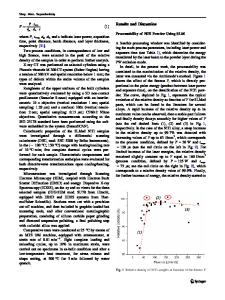Laser Processing of Net-Shape NiTi Shape Memory Alloy
- PDF / 566,864 Bytes
- 8 Pages / 593.972 x 792 pts Page_size
- 60 Downloads / 401 Views
INTRODUCTION
AMONG many biomedical metallic materials, Nitinol is gaining more attention due to its good biocompatibility, which is comparable to or better than Ti,[1] in combination with shape memory effect and superelasticity. Nitinol is characterized by a unique stress-strain diagram that is different from conventional biomedical alloys, but similar to that of living tissues. Figure 1 presents schematic stress-strain diagrams of three different materials.[1] In the case of stainless steel, the recoverable strain is less than 0.5 pct. On the other hand, up to 8 pct of deformation is recoverable in Nitinol.[2,3,4] Similarly, bone exhibits more than 1 pct recoverable strain as well as hysteresis in the loadingunloading cycles.[3] This similarity in the deformation behavior between Nitinol and bone contributes to the similar performance of load bearing implants, with that of natural bone, under loading-unloading conditions in the body, ensuring excellent biomechanical compatibility of Nitinol. The absence of high recoverable strain in load bearing metallic implants, similar to bone, is also one of the reasons for short in vivo life of implants. Maximum stress levels (400 to 500 MPa) in the femoral components of hip replacement prostheses[4] can be fully recovered due to shape memory effect in Nitinol without any residual plastic deformation. Moreover, Nitinol exhibits unique corrosion behavior after deformation in superelastic and plastic regimes in different deformation modes. It was shown that Nitinol maintains stable corrosion behavior[5] after deformation in tensile mode, the most damaging to the corrosion of metals,[6] and in B. VAMSI KRISHNA, Research Associate, SUSMITA BOSE, Associate Professor, and AMIT BANDYOPADHYAY, Professor, are with the W.M. Keck Biomedical Materials Research Lab, School of Mechanical and Materials Engineering, Washington State University, Pullman, WA 99164-2920, USA. Contact e-mail: [email protected] Manuscript submitted November 21, 2006. Article published online April 21, 2007. 1096—VOLUME 38A, MAY 2007
compression, its corrosion resistance increases remarkably after 25 pct strain.[7] Considerable research work has been devoted to powder metallurgical (PM) processing of NiTi shapememory alloys during the last two decades with the aim of fabricating near net-shape components. These techniques include solid-state sintering,[8,9,10] hot extrusion,[8] hot pressing,[8,11] hot isostatic pressing,[12,13,14] metal injection molding,[13] field-activated pressureassisted synthesis,[15] mechanical alloying,[16] and selfpropagating high-temperature/combustion synthesis.[17,18] However, there are several important problems associated with those routes. The embrittling oxide (Ti4Ni2Ox:0 < x £ 1) content of sintered alloys is generally high compared to melt-cast alloys.[19,20] Also, PM NiTi alloys usually contain a large amount of secondary phases such as Ti2Ni, Ni4Ti3, and Ni3Ti. Unfortunately, these thermodynamically stable compounds can not be eliminated during PM processing and require a secondary po
Data Loading...











